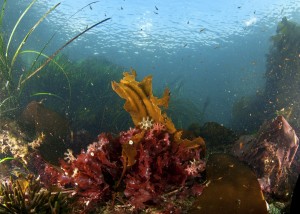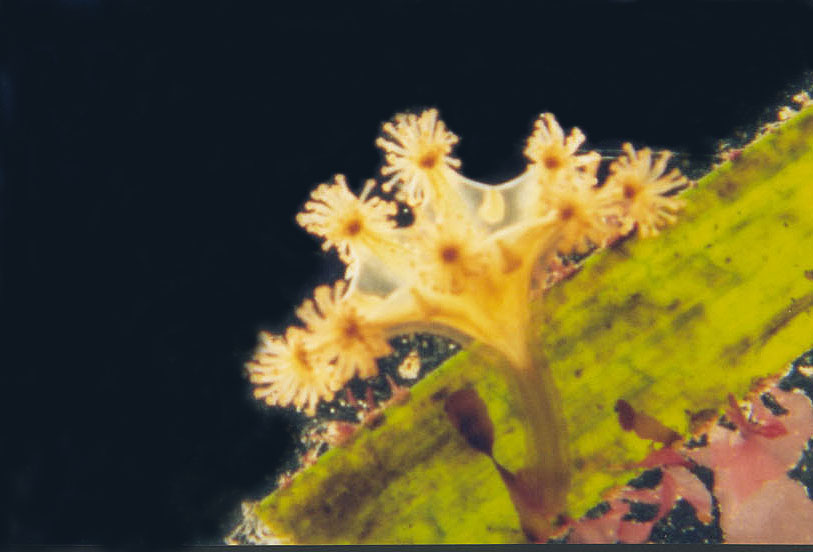These animals are best desribed as “upside down” medusae, with their bell extended into a stalk which is attached, in the case of this species, mostly to surfgrass leaves. They occur from low intertidal to the subtidal littoral. They feed mostly on caprellid amphipods. Natural size up to 1cm :
Note update on Taxonomy of :STAUROZOA*
“Stauromedusae are little stalked jellyfishes that spend their entire life attached to the substrate (rock or algae, usually), rather than swimming freely up in the water column like most other jellyfish. They have long been considered to be in the Order Stauromedusae in the Class Scyphozoa of the Phylum Cnidaria, but recent morphological and molecular studies (Marques and Collins, 2004; Collins and Daly, 2005) argued convincingly that they should be elevated to a rank equal to both the Scyphozoa and Cubozoa, as the Staurozoa. For those who prefer to apply taxonomic ranks, these might now all be considered Classes, but many scientists are pulling away from the concept of tight adherence to the old hierarchies of rank, in which case just “Staurozoa” will do.” (C.Mills)

Image by Ryan Murphy of the habitat of this animal, showing attachment to eel grass. Taken at Swordfish Island at 4 metres depth.
The Haliclystus salpinx is among the order of cnidarians which the more commonly known are jelly fish. Unlike jelly fish however this family of cnidarians is not free floating but more or less fixed, and always attached to the blade of eelgrass. It occurs frequently in the eelgrass bed around Swordfish island and Emdyck Pass near Bentinck island adjacent to Race RocksIt moves on very slowly or by somersaulting itself from one plant to another. Its physiological makeup has not been studied in enough detail at the present time how ever it shares some characteristics with more documented species. The Haliclystus salpinxas can be seen by the photo appears as an upside down medusae or in common terms jelly fish with its tentacles pointing outwards. The bell of the hydroid is then attached to a stalk that is stationery on the eel grass. It is found in the tidal and intertidal zones rendering it more conducive to shallow water as opposed to deep water.
| Domain | Eukarya |
| Kingdom | Animalia |
| Phylum | Cnidaria |
| Class | Staurozoa* |
| Order | Stauromedusae |
| Suborder | Eleutherocarpida |
| Family | Lucernariinae |
| Genus | Haliclystus |
| Species | salpinx (Clark, 1863) |
| COMMON NAME: | Stalked Jellyfish |
RANGE:
It is located most abundantly in the North Atlantic, Europe and Asia where areas are generally free external influences on rocky coasts. They are generally found in intertidal and tidal zones attached to surf grass.
REFERENCES CITED:
Mills, C.E. Internet 1999-2001. Stauromedusae: list of all valid species names. Electronic internet document available at http://faculty.washington.edu/cemills/Stauromedusae.html Published by author, web page established October 1999, last updated December 2nd 2001.
This file is provided as part of a collaborative effort by the students, faculty, volunteers and staff of Lester B. Pearson College– Dec 2001, by Sarah Gross

